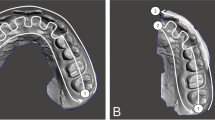Abstract
Objectives
The SureSmile® process (OraMetrix®; Richardson, TX, USA) utilizes computer-aided design and computer-aided manufacturing (CAD/CAM). A virtual setup is created for treatment planning and chairside implementation using custom archwires fabricated by robots. The objective of this study was to determine the precision of this implementation.
Methods
The setup models of 26 consecutive patients were compared to models of the final outcome. Using a virtual matching process, the planned and the achieved tooth positions were superimposed and the differences between them calculated along three translational planes and three rotational axes, thus, yielding six deviation values for each tooth.
Results
The median deviations were 0.19–0.21 mm based on translational movements and 1.77°–3.04° based on rotational movements. The precision of implementing the setups decreased from anterior to posterior, with incisors showing the best outcomes.
Conclusion
Virtual setups can be implemented in a clinically successful fashion with custom archwires fabricated by CAD/CAM in accordance with the SureSmile® process.
Zusammenfassung
Zielsetzung
Das untersuchte SureSmile-System (OraMetrix®, Richardson, Texas, USA) ist ein CAD/CAM-unterstütztes Verfahren, bei dem zur Behandlungsplanung ein virtuelles Set-up erstellt und dieses mit individuellen, robotergefertigten Bögen am Patienten umgesetzt wird. Ziel der Studie war es, die Präzision dieser Umsetzung zu bestimmen.
Material und Methode
Verglichen wurden hierfür die Set-up- und Abschlussmodelle von 26 konsekutiv behandelten Patienten. Geplante und tatsächlich erreichte Position wurden in einem virtuellen Matchingprozess überlagert und die Abweichungen in drei Ebenen und drei Achsen berechnet.
Ergebnisse
Ergebnis der Überlagerung waren sechs Messwerte für jedes korrespondierende Zahnpaar, die die Differenzen zwischen Set-up und Endsituation repräsentierten. Die mittleren Translationsabweichungen lagen zwischen 0.26 und 0.29 mm, die mittleren Rotationsabweichungen zwischen 2.75° und 3.89°. Das Set-up wurde an den Inzisivi am genauesten umgesetzt, von anterior nach posterior nahm die Präzision ab.
Schlussfolgerung
Mit Hilfe der CAD/CAM-gefertigten Bögen des SureSmile-Systems kann das Set-up klinisch erfolgreich umgesetzt werden.




Similar content being viewed by others
References
Balut N, Klapper L, Sandrik J et al (1992) Variations in bracket placement in the preadjusted orthodontic appliance. Am J Orthod Dentofacial Orthop 102:62–67
Breidenbach V, Schwestka-Polly R, Wiechmann D (2012) Ergebnisqualität von Laborprozessen in der Lingualtechnik: Vergleich der gängigen Verfahren. Inf Orthod Kieferorthop 44:99–112
Bryant RM, Sadowsky PL, Hazelrig JB (1984) Variability in three morphologic features of the permanent maxillary central incisor. Am J Orthod Dentofacial Orthop 86:25–32
Cash AC, Good SA, Curtis RV et al (2004) An evaluation of slot size in orthodontic brackets—are standards as expected? Angle Orthod 74:450–453
Creekmore TD (1979) Dr. Thomas D. Creekmore on torque. J Clin Orthod 13:305–310
Dahlberg G (1940) Statistical methods for medical and biological students. Interscience Publication, New York
Germane N, Bentley BE, Isaacson RJ (1989) Three biologic variables modifying faciolingual tooth angulation by straight-wire appliances. Am J Orthod Dentofacial Orthop 96:312–319
Grauer D, Proffit WR (2011) Accuracy in tooth positioning with a fully customized lingual orthodontic appliance. Am J Orthod Dentofacial Orthop 140:433–443
Jost-Brinkmann P, Gunawan A, Knieknecht A et al (2000) Bracketplatzierung mit der Slot-Machine. Kieferorthop 14:197–204
Kravitz ND, Kusnoto B, BeGole E et al (2009) How well does Invisalign work? A prospective clinical study evaluating the efficacy of tooth movement with Invisalign. Am J Orthod Dentofacial Orthop 135:27–35
Krieger E, Seiferth J, Marinello I et al (2012) Invisalign treatment in the anterior region: were the predicted tooth movements achieved? J Orofac Orthop 73:365–376
Krieger E, Seiferth J, Saric I et al (2011) Accuracy of Invisalign treatments in the anterior tooth region. First results. J Orofac Orthop 72:141–149
Larson BE, Vaubel CJ, Grunheid T (2013) Effectiveness of computer-assisted orthodontic treatment technology to achieve predicted outcomes. Angle Orthod 83:557–562
Mah J, Sachdeva R (2001) Computer-assisted orthodontic treatment: the SureSmile process. Am J Orthod Dentofacial Orthop 120:85–87
Meling TR, Odegaard J, Segner D (1998) On bracket slot height: a methodologic study. Am J Orthod Dentofacial Orthop 113:387–393
Müller-Hartwich R, Präger TM, Jost-Brinkmann P (2007) SureSmile - CAD/CAM system for orthodontic treatment planning, simulation and fabrication of customized archwires. Int J Comput Dent 10:53–62
Pauls AH (2010) Therapeutic accuracy of individualized brackets in lingual orthodontics. J Orofac Orthop 71:348–361
Thalheim A, Schwestka-Polly R (2008) Clinical Realisation of a Setup in Lingual Orthodontics. Inf Orthod Kieferorthop 40:277–282
Weber DJ, Koroluk LD, Phillips C et al (2013) Clinical effectiveness and efficiency of customized vs. conventional preadjusted bracket systems. J Clin Orthod 47:261–266
Wiechmann D (2002) A new bracket system for lingual orthodontic treatment. Part 1: theoretical background and development. J Orofac Orthop 63:234–245
Wiechmann D (2003) A new bracket system for lingual orthodontic treatment. Part 2: first clinical experiences and further development. J Orofac Orthop 64:372–388
Wong BH (2002) Invisalign A to Z. Am J Orthod Dentofacial Orthop 121:540–541
Author information
Authors and Affiliations
Corresponding author
Ethics declarations
Conflict of interest
Ralf Müller-Hartwich, Paul-Georg Jost-Brinkmann and Katharina Schubert state that there are no conflicts of interest.
Ethical statement
The accompanying manuscript does not include studies on humans or animals.
Rights and permissions
About this article
Cite this article
Müller-Hartwich, R., Jost-Brinkmann, PG. & Schubert, K. Precision of implementing virtual setups for orthodontic treatment using CAD/CAM-fabricated custom archwires. J Orofac Orthop 77, 1–8 (2016). https://doi.org/10.1007/s00056-015-0001-5
Received:
Accepted:
Published:
Issue Date:
DOI: https://doi.org/10.1007/s00056-015-0001-5




